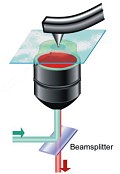 Swiss chemists have devised a new approach to the familiar analytical technique of Raman spectroscopy that allows them to investigate the structure of individual molecules.
Swiss chemists have devised a new approach to the familiar analytical technique of Raman spectroscopy that allows them to investigate the structure of individual molecules.
The full story is available today in advance of publication on SpectroscopyNOW’s Raman channel for Sciencebase readers only.
According to research team leader Renato Zenobi, there are two potentially very important applications of this new high-gain Raman technique:
- Molecular electronics – This is a field where individual molecules are being used as electronic elements (diodes, transistors, logic gates, etc.). One can, for example, imagine that a molecule would “switch” a current by a change in conformation (shape), which would of course be immediately reflected in a change of the Raman spectrum. Molecular diagnostic / analytical methods for this emerging field are largely missing so far. Here this methodology could make an important contribution, Zenobi told me.
- Cataysis – In catalytic conversions, A -> (B) -> (C) ->D , where A is the reactant, B and C are intermediates and D is the product, reactions are accelerated by a catalyst, by activating the molecules. Usually this happens on the surfaces of finely dispersed metal on a support material, i.e., it is generally surface process. Catalysis is employed in many industrially important chemical reactions, but – surprisingly – often the exact course of the reaction / the nature of the intermediates is not known. Again, identification of small numbers of molecules in tight spaces (= the nanoscale metallic “active sites” on catalysts) could be achieved with our methodology.